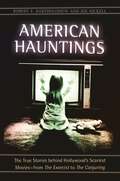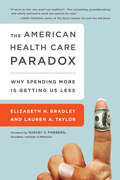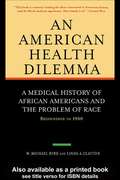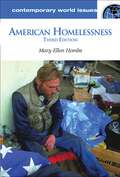- Table View
- List View
American Graffiti: George Lucas, the New Hollywood and the Baby Boom Generation (Cinema and Youth Cultures)
by Peter KrämerCombining a detailed film analysis with archival research and social science approaches, this book examines how American Graffiti (1973), a low-budget and star-less teen comedy by a filmmaker whose only previous feature had been a box office flop, became one of the highest grossing and most highly acclaimed films of all time in the United States, and one of the key expressions of the nostalgia wave washing over the country in the 1970s. American Graffiti: George Lucas, the New Hollywood and the Baby Boom Generation explores the origins and development of the film, its form and themes as well as its marketing, reception, audiences and impact. It does so by considering the life and career of the film’s co-writer and director George Lucas; the development and impact of the baby boom generation to which he, many of his collaborators and the vast majority of the film’s audience belonged; the transformation of the American film industry in the late 1960s and 1970s; and broader changes in American society which gave rise to an intense sense of crisis and growing pessimism across the population. This book is ideal for students, scholars and those with an interest in youth cinema, the New Hollywood and George Lucas as well as both Film and American Studies more broadly.
American Graffiti: George Lucas, the New Hollywood and the Baby Boom Generation (Cinema and Youth Cultures)
by Peter KrämerCombining a detailed film analysis with archival research and social science approaches, this book examines how American Graffiti (1973), a low-budget and star-less teen comedy by a filmmaker whose only previous feature had been a box office flop, became one of the highest grossing and most highly acclaimed films of all time in the United States, and one of the key expressions of the nostalgia wave washing over the country in the 1970s. American Graffiti: George Lucas, the New Hollywood and the Baby Boom Generation explores the origins and development of the film, its form and themes as well as its marketing, reception, audiences and impact. It does so by considering the life and career of the film’s co-writer and director George Lucas; the development and impact of the baby boom generation to which he, many of his collaborators and the vast majority of the film’s audience belonged; the transformation of the American film industry in the late 1960s and 1970s; and broader changes in American society which gave rise to an intense sense of crisis and growing pessimism across the population. This book is ideal for students, scholars and those with an interest in youth cinema, the New Hollywood and George Lucas as well as both Film and American Studies more broadly.
American Guy: Masculinity in American Law and Literature
American Guy examines American norms of masculinity and their role in the law, bringing a range of methodological and disciplinary perspectives to the intersection of American gender, legal, and literary issues. The collection opens with a set of papers investigating "American Guys" -- the heroic nonconformists and rugged individualists that populate much of American fiction. Diverse essays examine the manly men of Hemingway, Dreiser, and others, in their relation to the law, while also highlighting the underlying tensions that complicate this version of masculinity. A second set of papers examines "Outsiders" -- men on the periphery of the American Guys who proclaim a different way of being male. These essays take up counter-traditions of masculinity ranging from gay male culture to Philip Roth's portrait of the Jewish lawyer. American Guy, a follow-up to Subversion and Sympathy, edited by Alison L. LaCroix and Martha Nussbaum, aims at reinvigorating the law-and-literature movement through original, cross-disciplinary insights. It embraces a variety of voices from both within and outside the academy, including several contributions from prominent judges. These contributions are particularly significant, not only as features unique to the field, but also for the light they throw on the federal bench. In the face of a large body of work studying judicial conduct as a function of rigid commitment to ideology, American Guy shows a side of the judiciary that is imaginatively engaged, aware of cultural trends, and reflective about the wider world and the role of the of law in it.
American Hauntings: The True Stories behind Hollywood's Scariest Movies—from The Exorcist to The Conjuring
by Robert E. Bartholomew Joe NickellThis work provides an accurate, in-depth examination and scientific evaluation of the most famous hauntings in American history as depicted in popular films and television programs.Neither a debunking book nor one written for the "true believer" in the paranormal, American Hauntings objectively scrutinizes the historic evidence behind such hugely popular films as The Exorcist, The Amityville Horror, An American Haunting, The Conjuring, and The Haunting in Connecticut to ascertain the accuracy of these entertainment depictions of "true life" hauntings. The authors then compare these popular culture accounts against the alleged real-life encounters and impartially weigh the evidence to assess whether each incident actually took place.Written by highly credentialed, recognized authorities on the paranormal and social psychology, this book contains meticulously documented, science-based information written for a broad audience, from middle and high school students and those taking introductory courses at a university level to general readers. There is no other work that provides as careful and unbiased an evaluation of the most famous hauntings in American history. The book also examines the reliability of popular television shows such as Unsolved Mysteries and Paranormal Witness.
American Hauntings: The True Stories behind Hollywood's Scariest Movies—from The Exorcist to The Conjuring
by Robert E. Bartholomew Joe NickellThis work provides an accurate, in-depth examination and scientific evaluation of the most famous hauntings in American history as depicted in popular films and television programs.Neither a debunking book nor one written for the "true believer" in the paranormal, American Hauntings objectively scrutinizes the historic evidence behind such hugely popular films as The Exorcist, The Amityville Horror, An American Haunting, The Conjuring, and The Haunting in Connecticut to ascertain the accuracy of these entertainment depictions of "true life" hauntings. The authors then compare these popular culture accounts against the alleged real-life encounters and impartially weigh the evidence to assess whether each incident actually took place.Written by highly credentialed, recognized authorities on the paranormal and social psychology, this book contains meticulously documented, science-based information written for a broad audience, from middle and high school students and those taking introductory courses at a university level to general readers. There is no other work that provides as careful and unbiased an evaluation of the most famous hauntings in American history. The book also examines the reliability of popular television shows such as Unsolved Mysteries and Paranormal Witness.
The American Health Care Paradox: Why Spending More is Getting Us Less
by Elizabeth H. Bradley Lauren A. TaylorForeword by Harvey V. Fineberg, President of the Institute of MedicineFor decades, experts have puzzled over why the US spends more on health care but suffers poorer outcomes than other industrialized nations. Now Elizabeth H. Bradley and Lauren A. Taylor marshal extensive research, including a comparative study of health care data from thirty countries, and get to the root of this paradox: We've left out of our tally the most impactful expenditures countries make to improve the health of their populations-investments in social services. In The American Health Care Paradox, Bradley and Taylor illuminate how narrow definitions of "health care," archaic divisions in the distribution of health and social services, and our allergy to government programs combine to create needless suffering in individual lives, even as health care spending continues to soar. They show us how and why the US health care "system" developed as it did; examine the constraints on, and possibilities for, reform; and profile inspiring new initiatives from around the world. Offering a unique and clarifying perspective on the problems the Affordable Care Act won't solve, this book also points a new way forward.
The American Health Care Paradox: Why Spending More is Getting Us Less
by Elizabeth H. Bradley Lauren A TaylorForeword by Harvey V. Fineberg, President of the Institute of Medicine For decades, experts have puzzled over why the US spends more on health care but suffers poorer outcomes than other industrialized nations. Now Elizabeth H. Bradley and Lauren A. Taylor marshal extensive research, including a comparative study of health care data from thirty countries, and get to the root of this paradox: We've left out of our tally the most impactful expenditures countries make to improve the health of their populations-investments in social services. In The American Health Care Paradox, Bradley and Taylor illuminate how narrow definitions of "health care," archaic divisions in the distribution of health and social services, and our allergy to government programs combine to create needless suffering in individual lives, even as health care spending continues to soar. They show us how and why the US health care "system" developed as it did; examine the constraints on, and possibilities for, reform; and profile inspiring new initiatives from around the world. Offering a unique and clarifying perspective on the problems the Affordable Care Act won't solve, this book also points a new way forward.
An American Health Dilemma: A Medical History of African Americans and the Problem of Race: Beginnings to 1900
by W. Michael Byrd Linda A. ClaytonAt times mirroring and at times shockingly disparate to the rise of traditional white American medicine, the history of African-American health care is a story of traditional healers; root doctors; granny midwives; underappreciated and overworked African-American physicians; scrupulous and unscrupulous white doctors and scientists; governmental support and neglect; epidemics; and poverty. Virtually every part of this story revolves around race. More than 50 years after the publication of An American Dilemma, Gunnar Myrdal's 1944 classic about race relations in the USA, An American Health Dilemma presents a comprehensive and groundbreaking history and social analysis of race, race relations and the African-American medical and public health experience. Beginning with the origins of western medicine and science in Egypt, Greece and Rome the authors explore the relationship between race, medicine, and health care from the precursors of American science and medicine through the days of the slave trade with the harrowing middle passage and equally deadly breaking-in period through the Civil War and the gains of reconstruction and the reversals caused by Jim Crow laws. It offers an extensive examination of the history of intellectual and scientific racism that evolved to give sanction to the mistreatment, medical abuse, and neglect of African Americans and other non-white people. Also included are biographical portraits of black medical pioneers like James McCune Smith, the first African American to earn a degree from a European university, and anecdotal vignettes,like the tragic story of "the Hottentot Venus", which illustrate larger themes.An American Health Dilemma promises to become an irreplaceable and essential look at African-American and medical history and will provide an invaluable baseline for future exploration of race and racism in the American health system.
An American Health Dilemma: A Medical History of African Americans and the Problem of Race: Beginnings to 1900
by W. Michael Byrd Linda A. ClaytonAt times mirroring and at times shockingly disparate to the rise of traditional white American medicine, the history of African-American health care is a story of traditional healers; root doctors; granny midwives; underappreciated and overworked African-American physicians; scrupulous and unscrupulous white doctors and scientists; governmental support and neglect; epidemics; and poverty. Virtually every part of this story revolves around race. More than 50 years after the publication of An American Dilemma, Gunnar Myrdal's 1944 classic about race relations in the USA, An American Health Dilemma presents a comprehensive and groundbreaking history and social analysis of race, race relations and the African-American medical and public health experience. Beginning with the origins of western medicine and science in Egypt, Greece and Rome the authors explore the relationship between race, medicine, and health care from the precursors of American science and medicine through the days of the slave trade with the harrowing middle passage and equally deadly breaking-in period through the Civil War and the gains of reconstruction and the reversals caused by Jim Crow laws. It offers an extensive examination of the history of intellectual and scientific racism that evolved to give sanction to the mistreatment, medical abuse, and neglect of African Americans and other non-white people. Also included are biographical portraits of black medical pioneers like James McCune Smith, the first African American to earn a degree from a European university, and anecdotal vignettes,like the tragic story of "the Hottentot Venus", which illustrate larger themes.An American Health Dilemma promises to become an irreplaceable and essential look at African-American and medical history and will provide an invaluable baseline for future exploration of race and racism in the American health system.
American Hegemony and the Rise of Emerging Powers: Cooperation or Conflict (ISSN)
by James Parisot Salvador Santino F. RegilmeOver the last decade, the United States' position as the world's most powerful state has appeared increasingly unstable. The US invasions of Afghanistan and Iraq, non-traditional security threats, global economic instability, the apparent spread of authoritarianism and illiberal politics, together with the rise of emerging powers from the Global South have led many to predict the end of Western dominance on the global stage. This book brings together scholars from international relations, economics, history, sociology and area studies to debate the future of US leadership in the international system. The book analyses the past, present and future of US hegemony in key regions in the Asia-Pacific, Latin America, Middle East, Europe and Africa – while also examining the dynamic interactions of US hegemony with other established, rising and re-emerging powers such as Russia, China, Japan, India, Turkey and South Africa.American Hegemony and the Rise of Emerging Powers explores how changes in the patterns of cooperation and conflict among states, regional actors and transnational non-state actors have affected the rise of emerging global powers and the suggested decline of US leadership. Scholars, students and policy practitioners who are interested in the future of the US-led international system, the rise of emerging powers from the Global South and related global policy challenges will find this multidisciplinary volume an invaluable guide to the shifting position of American hegemony.The Open Access version of this book, available at http://www.taylorfrancis.com, has been made available under a Creative Commons Attribution-Non Commercial-No Derivatives (CC-BY-ND) 4.0 license.
American Hegemony and the Rise of Emerging Powers: Cooperation or Conflict (ISSN)
by Salvador Santino Regilme James ParisotOver the last decade, the United States' position as the world's most powerful state has appeared increasingly unstable. The US invasions of Afghanistan and Iraq, non-traditional security threats, global economic instability, the apparent spread of authoritarianism and illiberal politics, together with the rise of emerging powers from the Global South have led many to predict the end of Western dominance on the global stage. This book brings together scholars from international relations, economics, history, sociology and area studies to debate the future of US leadership in the international system. The book analyses the past, present and future of US hegemony in key regions in the Asia-Pacific, Latin America, Middle East, Europe and Africa – while also examining the dynamic interactions of US hegemony with other established, rising and re-emerging powers such as Russia, China, Japan, India, Turkey and South Africa.American Hegemony and the Rise of Emerging Powers explores how changes in the patterns of cooperation and conflict among states, regional actors and transnational non-state actors have affected the rise of emerging global powers and the suggested decline of US leadership. Scholars, students and policy practitioners who are interested in the future of the US-led international system, the rise of emerging powers from the Global South and related global policy challenges will find this multidisciplinary volume an invaluable guide to the shifting position of American hegemony.The Open Access version of this book, available at http://www.taylorfrancis.com, has been made available under a Creative Commons Attribution-Non Commercial-No Derivatives (CC-BY-ND) 4.0 license.
American History Goes to the Movies: Hollywood and the American Experience
by W. Bryan Rommel RuizWhether they prefer blockbusters, historical dramas, or documentaries, people learn much of what they know about history from the movies. In American History Goes to the Movies, W. Bryan Rommel-Ruiz shows how popular representations of historic events shape the way audiences understand the history of the United States, including American representations of race and gender, and stories of immigration, especially the familiar narrative of the American Dream. Using films from many different genres, American History Goes to the Movies draws together movies that depict the Civil War, the Wild West, the assassination of JFK, and the events of 9/11, from The Birth of a Nation and Gone with the Wind to The Exorcist and United 93, to show how viewers use movies to make sense of the past, addressing not only how we render history for popular enjoyment, but also how Hollywood’s renderings of America influence the way Americans see themselves and how they make sense of the world.
American History Goes to the Movies: Hollywood and the American Experience
by W. Bryan Rommel RuizWhether they prefer blockbusters, historical dramas, or documentaries, people learn much of what they know about history from the movies. In American History Goes to the Movies, W. Bryan Rommel-Ruiz shows how popular representations of historic events shape the way audiences understand the history of the United States, including American representations of race and gender, and stories of immigration, especially the familiar narrative of the American Dream. Using films from many different genres, American History Goes to the Movies draws together movies that depict the Civil War, the Wild West, the assassination of JFK, and the events of 9/11, from The Birth of a Nation and Gone with the Wind to The Exorcist and United 93, to show how viewers use movies to make sense of the past, addressing not only how we render history for popular enjoyment, but also how Hollywood’s renderings of America influence the way Americans see themselves and how they make sense of the world.
American History through American Sports [3 volumes]: From Colonial Lacrosse to Extreme Sports [3 volumes]
by Danielle Sarver Coombs Bob BatchelorFilled with insightful analysis and compelling arguments, this book considers the influence of sports on popular culture and spotlights the fascinating ways in which sports culture and American culture intersect.This collection blends historical and popular culture perspectives in its analysis of the development of sports and sports figures throughout American history. American History through American Sports: From Colonial Lacrosse to Extreme Sports is unique in that it focuses on how each sport has transformed and influenced society at large, demonstrating how sports and popular culture are intrinsically entwined and the ways they both reflect larger societal transformations. The essays in the book are wide-ranging, covering topics of interest for sports fans who enjoy the NFL and NASCAR as well as those who like tennis and watching the Olympics. Many topics feature information about specific sports icons and favorite heroes. Additionally, many of the topics' treatments prompt engagement by purposely challenging the reader to either agree or disagree with the author's analysis.
American History through American Sports [3 volumes]: From Colonial Lacrosse to Extreme Sports [3 volumes]
Filled with insightful analysis and compelling arguments, this book considers the influence of sports on popular culture and spotlights the fascinating ways in which sports culture and American culture intersect.This collection blends historical and popular culture perspectives in its analysis of the development of sports and sports figures throughout American history. American History through American Sports: From Colonial Lacrosse to Extreme Sports is unique in that it focuses on how each sport has transformed and influenced society at large, demonstrating how sports and popular culture are intrinsically entwined and the ways they both reflect larger societal transformations. The essays in the book are wide-ranging, covering topics of interest for sports fans who enjoy the NFL and NASCAR as well as those who like tennis and watching the Olympics. Many topics feature information about specific sports icons and favorite heroes. Additionally, many of the topics' treatments prompt engagement by purposely challenging the reader to either agree or disagree with the author's analysis.
American Holocaust: The Conquest of the New World
by David E. StannardFor four hundred years--from the first Spanish assaults against the Arawak people of Hispaniola in the 1490s to the U.S. Army's massacre of Sioux Indians at Wounded Knee in the 1890s--the indigenous inhabitants of North and South America endured an unending firestorm of violence. During that time the native population of the Western Hemisphere declined by as many as 100 million people. Indeed, as historian David E. Stannard argues in this stunning new book, the European and white American destruction of the native peoples of the Americas was the most massive act of genocide in the history of the world. Stannard begins with a portrait of the enormous richness and diversity of life in the Americas prior to Columbus's fateful voyage in 1492. He then follows the path of genocide from the Indies to Mexico and Central and South America, then north to Florida, Virginia, and New England, and finally out across the Great Plains and Southwest to California and the North Pacific Coast. Stannard reveals that wherever Europeans or white Americans went, the native people were caught between imported plagues and barbarous atrocities, typically resulting in the annihilation of 95 percent of their populations. What kind of people, he asks, do such horrendous things to others? His highly provocative answer: Christians. Digging deeply into ancient European and Christian attitudes toward sex, race, and war, he finds the cultural ground well prepared by the end of the Middle Ages for the centuries-long genocide campaign that Europeans and their descendants launched--and in places continue to wage--against the New World's original inhabitants. Advancing a thesis that is sure to create much controversy, Stannard contends that the perpetrators of the American Holocaust drew on the same ideological wellspring as did the later architects of the Nazi Holocaust. It is an ideology that remains dangerously alive today, he adds, and one that in recent years has surfaced in American justifications for large-scale military intervention in Southeast Asia and the Middle East. At once sweeping in scope and meticulously detailed, American Holocaust is a work of impassioned scholarship that is certain to ignite intense historical and moral debate.
American Holocaust: The Conquest of the New World
by David E. StannardFor four hundred years--from the first Spanish assaults against the Arawak people of Hispaniola in the 1490s to the U.S. Army's massacre of Sioux Indians at Wounded Knee in the 1890s--the indigenous inhabitants of North and South America endured an unending firestorm of violence. During that time the native population of the Western Hemisphere declined by as many as 100 million people. Indeed, as historian David E. Stannard argues in this stunning new book, the European and white American destruction of the native peoples of the Americas was the most massive act of genocide in the history of the world. Stannard begins with a portrait of the enormous richness and diversity of life in the Americas prior to Columbus's fateful voyage in 1492. He then follows the path of genocide from the Indies to Mexico and Central and South America, then north to Florida, Virginia, and New England, and finally out across the Great Plains and Southwest to California and the North Pacific Coast. Stannard reveals that wherever Europeans or white Americans went, the native people were caught between imported plagues and barbarous atrocities, typically resulting in the annihilation of 95 percent of their populations. What kind of people, he asks, do such horrendous things to others? His highly provocative answer: Christians. Digging deeply into ancient European and Christian attitudes toward sex, race, and war, he finds the cultural ground well prepared by the end of the Middle Ages for the centuries-long genocide campaign that Europeans and their descendants launched--and in places continue to wage--against the New World's original inhabitants. Advancing a thesis that is sure to create much controversy, Stannard contends that the perpetrators of the American Holocaust drew on the same ideological wellspring as did the later architects of the Nazi Holocaust. It is an ideology that remains dangerously alive today, he adds, and one that in recent years has surfaced in American justifications for large-scale military intervention in Southeast Asia and the Middle East. At once sweeping in scope and meticulously detailed, American Holocaust is a work of impassioned scholarship that is certain to ignite intense historical and moral debate.
American Homelessness: A Reference Handbook (Contemporary World Issues)
by Mary Ellen HombsWith 50 percent new material, this third edition breaks this complex topic into key elements, examining the roots of the problem, programs that address it, current research, and public perceptions of homelessness.American Homelessness covers who the homeless are and why they are in such a situation; important events that have contributed to the problem; and a who's who of homelessness activism including people such as MacArthur Fellow Robert M. Hayes, the former securities lawyer who filed the landmark New York City right-to-shelter case in l979. It also includes a chronology; facts and statistics; key documents and reports; a discussion of the International Bill of Rights; a directory of organizations, associations, and government agencies; and an annotated bibliography.
American Homicide
by Randolph RothIn American Homicide, Randolph Roth charts changes in the character and incidence of homicide in the U.S. from colonial times to the present. Roth argues that the United States is distinctive in its level of violence among unrelated adults—friends, acquaintances, and strangers. America was extraordinarily homicidal in the mid-seventeenth century, but it became relatively non-homicidal by the mid-eighteenth century, even in the slave South; and by the early nineteenth century, rates in the North and the mountain South were extremely low. But the homicide rate rose substantially among unrelated adults in the slave South after the American Revolution; and it skyrocketed across the United States from the late 1840s through the mid-1870s, while rates in most other Western nations held steady or fell. That surge—and all subsequent increases in the homicide rate—correlated closely with four distinct phenomena: political instability; a loss of government legitimacy; a loss of fellow-feeling among members of society caused by racial, religious, or political antagonism; and a loss of faith in the social hierarchy. Those four factors, Roth argues, best explain why homicide rates have gone up and down in the United States and in other Western nations over the past four centuries, and why the United States is today the most homicidal affluent nation.
American Honor: The Creation of the Nation's Ideals during the Revolutionary Era
by Craig Bruce SmithThe American Revolution was not only a revolution for liberty and freedom, it was also a revolution of ethics, reshaping what colonial Americans understood as "honor" and "virtue." As Craig Bruce Smith demonstrates, these concepts were crucial aspects of Revolutionary Americans' ideological break from Europe and shared by all ranks of society. Focusing his study primarily on prominent Americans who came of age before and during the Revolution—notably John Adams, Benjamin Franklin, Thomas Jefferson, and George Washington—Smith shows how a colonial ethical transformation caused and became inseparable from the American Revolution, creating an ethical ideology that still remains.By also interweaving individuals and groups that have historically been excluded from the discussion of honor—such as female thinkers, women patriots, slaves, and free African Americans—Smith makes a broad and significant argument about how the Revolutionary era witnessed a fundamental shift in ethical ideas. This thoughtful work sheds new light on a forgotten cause of the Revolution and on the ideological foundation of the United States.
American Horror Fiction: From Brockden Brown to Stephen King (Insights Ser.)
by Brian DochertyThis volume offers critical and theoretical perspectives on a genre which has remained popular for nearly two hundred years: American horror fiction. There are essays on Charles Brockden Brown, Edgar Allan Poe, H.P.Lovecraft, William Faulkner, Robert Bloch, Patricia Highsmith, Shirley Jackson, Stephen King and Suzy McKee Charnas, covering the period from 1798 to 1983. Each essay deals with a major figure in the genre, from Gothic orginators to modern feminist reworkings. A variety of reading strategies are employed to interrogate these texts, with feminist and psychoanalytic approaches well represented. These essays illustrate the fact that modern literary theory can usefully be applied to any text or genre. Students of horror fiction seeking new readings, and readers interested in modern approaches to literature, will find this book useful and informative. The essays are all new, and have been specially written for Insights by leading academics.
American Horror Fiction and Class: From Poe to Twilight (Palgrave Gothic)
by David SimmonsIn this book, Simmons argues that class, as much as race and gender, played a significant role in the development of Gothic and Horror fiction in a national context. From the classic texts of Edgar Allen Poe and Nathaniel Hawthorne right through to contemporary examples, such as the novels of Stephen King and Stephenie Meyer’s Twilight Series, class remains an ever present though understudied element. This study will appeal to scholars of American Studies, English literature, Media and Cultural Studies interested in class representations in the horror genre from the nineteenth century to the present day.
American Hungers: The Problem of Poverty in U.S. Literature, 1840-1945
by Gavin JonesSocial anxiety about poverty surfaces with startling frequency in American literature. Yet, as Gavin Jones argues, poverty has been denied its due as a critical and ideological framework in its own right, despite recent interest in representations of the lower classes and the marginalized. These insights lay the groundwork for American Hungers, in which Jones uncovers a complex and controversial discourse on the poor that stretches from the antebellum era through the Depression. Reading writers such as Herman Melville, Theodore Dreiser, Edith Wharton, James Agee, and Richard Wright in their historical contexts, Jones explores why they succeeded where literary critics have fallen short. These authors acknowledged a poverty that was as aesthetically and culturally significant as it was socially and materially real. They confronted the ideological dilemmas of approaching poverty while giving language to the marginalized poor--the beggars, tramps, sharecroppers, and factory workers who form a persistent segment of American society. Far from peripheral, poverty emerges at the center of national debates about social justice, citizenship, and minority identity. And literature becomes a crucial tool to understand an economic and cultural condition that is at once urgent and elusive because it cuts across the categories of race, gender, and class by which we conventionally understand social difference. Combining social theory with literary analysis, American Hungers masterfully brings poverty into the mainstream critical idiom.
American Hungers: The Problem of Poverty in U.S. Literature, 1840-1945 (PDF)
by Gavin JonesSocial anxiety about poverty surfaces with startling frequency in American literature. Yet, as Gavin Jones argues, poverty has been denied its due as a critical and ideological framework in its own right, despite recent interest in representations of the lower classes and the marginalized. These insights lay the groundwork for American Hungers, in which Jones uncovers a complex and controversial discourse on the poor that stretches from the antebellum era through the Depression. Reading writers such as Herman Melville, Theodore Dreiser, Edith Wharton, James Agee, and Richard Wright in their historical contexts, Jones explores why they succeeded where literary critics have fallen short. These authors acknowledged a poverty that was as aesthetically and culturally significant as it was socially and materially real. They confronted the ideological dilemmas of approaching poverty while giving language to the marginalized poor--the beggars, tramps, sharecroppers, and factory workers who form a persistent segment of American society. Far from peripheral, poverty emerges at the center of national debates about social justice, citizenship, and minority identity. And literature becomes a crucial tool to understand an economic and cultural condition that is at once urgent and elusive because it cuts across the categories of race, gender, and class by which we conventionally understand social difference. Combining social theory with literary analysis, American Hungers masterfully brings poverty into the mainstream critical idiom.
An American Icon in Puerto Rico: Barbie, Girlhood, and Colonialism at Play (Transnational Girlhoods #4)
by Emily R. Aguiló-PérezSince her creation in 1959, Barbie has become an icon of femininity to girls all over the world. In this study, author Emily R. Aguiló-Pérez focuses on a group of multigenerational Puerto Rican women and girls, exploring how playing with Barbie dolls as children has impacted their lives. By documenting the often-complicated relationships girls have with Barbie dolls, Aguiló-Pérez highlights the ways through which women and girls construct their own identities in relation to femininity, body image, race, and nationalism through Barbie play.
















